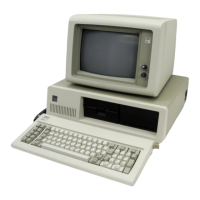Description
The
Math
Coprocessor (8087) enables the IBM Personal
Computer to perform high-speed arithmetic, logarithmic
functions, and trigonometric operations with extreme accuracy.
The 8087 coprocessor works in parallel with the microprocessor.
The parallel operation decreases operating time by allowing the
coprocessor to do mathematical calculations while the
microprocessor continues to do other functions.
The first five bits of every instruction's operation code for the
coprocessor are identical (binary 11011). When the
microprocessor and the coprocessor see this operation code, the
microprocessor calculates the address of any variables in memory,
while the coprocessor checks the instruction. The coprocessor
takes the memory address from the microprocessor if necessary.
To
gain access to locations in memory, the coprocessor takes the
local bus from the microprocessor when the microprocessor
finishes its current instruction. When the coprocessor
is
finished
with the memory transfer, it returns the local bus to the
microprocessor.
The IBM
Math
Coprocessor works with seven numeric
data
types
divided into the three classes listed below.
• Binary integers (3 types)
• Decimal integers
(1
type)
• Real numbers (3 types).
Coprocessor 2-3

